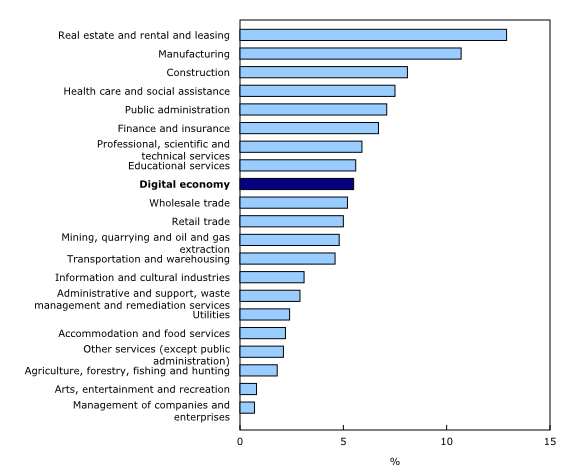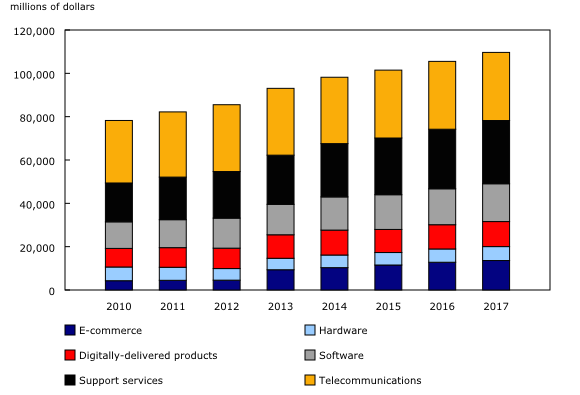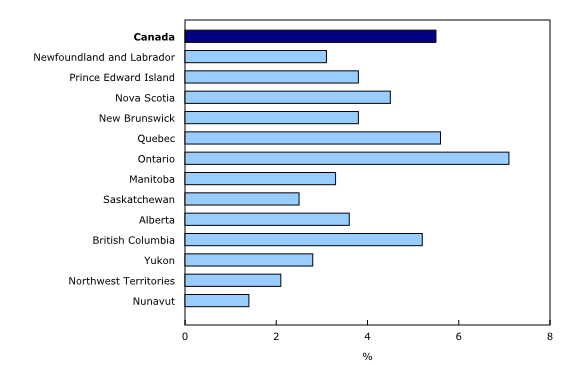Measuring digital economic activities in Canada, 2010 to 2017
Archived Content
Information identified as archived is provided for reference, research or recordkeeping purposes. It is not subject to the Government of Canada Web Standards and has not been altered or updated since it was archived. Please "contact us" to request a format other than those available.
Released: 2019-05-03
New statistical measures for the digital age
Advancements in technology and the Internet have fundamentally changed how people and businesses interact and how they produce, distribute and consume goods and services. As technological advancement continues and digitalization rapidly expands to more segments of the economy, there is an increasing need to accurately measure and assess its impacts.
Today, Statistics Canada is releasing for the first time estimates of the economic value of digital economic activities, that is, activities that enable or are highly affected by digitization. Initial estimates are presented on the value, growth and nature of digital economic activities in Canada, the provinces and the territories.
To enhance these initial estimates and ensure that statistical measures reflect emerging economic phenomena, Statistics Canada will continue to explore innovative ways to measure the digitalization of the economy. This includes moving beyond traditional household and business surveys—many of which are not well suited to capturing digital economic activities—to using new data sources and methods, such as administrative data, crowdsourcing and web scraping.
Growth of digital economic activities outpaces economy-wide gross domestic product
The nominal gross domestic product (GDP) associated with digital economic activities was $109.7 billion, or 5.5%, of total economic activity in Canada in 2017. Digital economic activities, commonly referred to as the digital economy, include activities that enable digitization or are highly affected by it. For example, the digital economy includes the information technology equipment that it relies upon to function, as well as e-commerce transactions and the digital delivery of products to consumers.
While the digital economy is not an industry, to give a sense of its scale, it was larger as a proportion of the total economy than mining, quarrying and oil and gas extraction (4.8%), transportation and warehousing (4.6%) and utilities (2.4%) in 2015.
From 2010 to 2017, the nominal GDP of digital economic activities (+40.2%) grew at a faster pace than the overall economy (+28.0%). On an annual basis, the digital economy increased more than the total economy every year except in 2011 and 2017, which were years of strong growth in the energy sector.
Telecommunications was the largest contributor to the digital economy
Telecommunications, part of the digital-enabling infrastructure domain, was the largest contributor to the digital economy in Canada. However, its contribution declined from 36.9% in 2010 to 28.7% in 2017. Over the same period, the contribution of e-commerce more than doubled, from 5.5% of the digital economy to 12.4%.
Digital economy job growth more than four times that of the total economy
In 2017 there were 886,114 jobs associated with digital economic activities, representing 4.7% of all jobs in Canada.
While the proportion of digital economy jobs was smaller than the share of GDP and output, jobs associated with the digital economy (+37.0%) grew at more than four times the pace of economy-wide job growth (+8.6%) from 2010 to 2017.
The largest contributors to digital economy jobs in 2017 were support services (30.2%), followed by e-commerce (18.6%). The hardware domain (6.4%) represented the smallest share of digital economy jobs.
Contribution of the digital economy varies by province and territory
In 2017, digital economic activities accounted for the largest share of total economic activities in Ontario, Quebec and British Columbia. The proportion of digital economic activities in relation to overall economic activity was the smallest in the three territories and in Saskatchewan.
From 2010 to 2017, nominal GDP of the digital economy grew in every province and territory. However, Manitoba, Yukon and Nunavut saw slower digital economy growth over the seven-year period when compared with nominal economy-wide GDP.
On a regional basis, British Columbia (+49.1%) and Quebec (+41.0%) saw the largest gains in digital economy jobs from 2010 to 2017, while Newfoundland and Labrador (-9.1%) and the Northwest Territories (-3.5%) reported the only declines.
Note to readers
The estimates released today represent a first attempt at estimating the size, growth and nature of digital economic activities in Canada, the provinces and territories. Digital economic activities, commonly referred to as the digital economy, include those activities that enable digitization or are highly affected by it. For example, the digital economy includes the information technology equipment that it relies upon to function, as well as e-commerce transactions and the digital delivery of products to consumers.
These estimates were derived using the Canadian supply and use framework.
This work borrows heavily from Organisation for Economic Co-operation and Development literature, including its proposed framework for a digital economy satellite account. The estimates also use concepts and definitions similar to those used by the US Bureau of Economic Analysis in "Defining and Measuring the Digital Economy."
All estimates are expressed in nominal basic prices.
The estimate of jobs includes both paid and self-employed jobs associated with the production of digital economy products. It does not take into account the characteristics of the jobs themselves. This means that, for example, a custodian working in the telecommunications industry is captured because they contribute to the production of a digital economy product, while a data analyst or computer engineer working in an agriculture industry is not captured, according to the definition in this study.
Digital-enabling infrastructure includes the information technology equipment, systems, software, services and structures that the digital economy relies upon to function.
E-commerce consists of the retail and wholesale margins on sales of goods or services for which the order is received and the commitment to purchase is made via the Internet, even if payment is made by other means.
Digitally delivered products consist of services transmitted and consumed in digital format.
Products
The document "Measuring digital economic activities in Canada: initial estimates," which is part of Latest Developments in the Canadian Economic Accounts (13-605-X), is now available.
The User Guide: Canadian System of Macroeconomic Accounts (13-606-G) is available.
The Methodological Guide: Canadian System of Macroeconomic Accounts (13-607-X) is available.
Contact information
For more information, or to enquire about the concepts, methods or data quality of this release, contact us (toll-free 1-800-263-1136; 514-283-8300; STATCAN.infostats-infostats.STATCAN@canada.ca) or Media Relations (613-951-4636; STATCAN.mediahotline-ligneinfomedias.STATCAN@canada.ca).
- Date modified:





